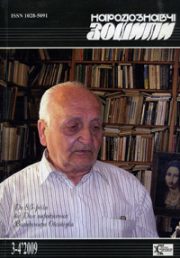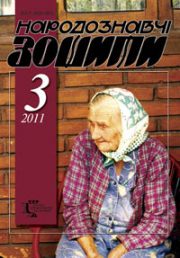The Ethnology Notebooks. 2019, № 6 (150), 1447—1463
UDK7.046.3
DOI https://doi.org/10.15407/nz2019.06.1447
ZHYSHKOVYCH Volodymyr
ORCID ID: https://orcid.org/0000-0003-2699-4907
Ph.D., Senior Researcher of the Institute of Ethnology
of the National Academy of Sciences of Ukraine,
Department of Art Studies,
15, Svobody Avenue, 79000, Lviv, Ukraine
е-mail: zhyshko@i.ua
Abstract. Introduction. The creative achievements of a Lviv artist, author of the famous icon «Praise of the Virgin» from Ripniv village is considered. According to the author’s signature, the icon was created in Lviv in 1599 by painter Fedor, who is identified as Fedir Sen’kovych. The figure of the leading Lviv icon-painter Fyodor Sen’kovych attracted the attention of several generations of researchers, but there is still no definitive opinion on the undisputed authorship of the works he created, and a number of unanswered questions remain, and this is why the relevance of the proposed research.
Problem Statement. The purpose of the article is to distinguish the inherent features of the artist’s trait, artistic and plastic features, to reveal the phased appearance of the works created by him and his workshop. The object of the study is the iconic heritage of Fyodor Sen’kovych; the subject is the peculiarities of the evolution of his creative manner, as one of the important factors of the attribution of the iconographic works of the Lviv artistic center of the late 16th — first third of the 17th centuries. The methodological basis of the study is comparative-typological and historical-cultural methods.
Results. The article, based on the analysis of historiographical sources and preserved works, by using the method of comparative analysis of artistic and stylistic features of creative manner, proves that a number of works that were recently connected with other artists were probably created by Fedor Sen’kovych or under his direction.
Conclusion. The conducted research gives grounds to claim that during the first third of the 17th century Fedir Sen’kovych in two stages worked on the creation of the Assumption and Friday Church iconostases in Lviv. According to art and style signs the icon-writing manner of the artist can also be traced in a number of other churches of Lviv and its regions.
During the first third of the 17th century Fedir Sen’kovych was the most famous icon painter and head of a leading icon-painting workshop, around which a powerful highly professional Lviv icon-painting center was formed. After the death in 1631 the artistic and plastic foundations of Lviv icon painting, laid by Fyodor Sen’kovych were developed by his students and in particular by the successor of his studio Mykola Petrakhnovych Morokhovsky.
Keywords: Lviv, church, iconostasis, icon painting, iconography, style, artistic features, Fedir Sen’kovych.
Received 7.11.2019
REFERENCES
Aleksandrovych, V.S, & Richkov, P.A. (2008). St. George’s Cathedral in Lviv. Kyiv: Tekhnika [in Ukrainian].
Holubets’, M. (1920). Ukrainian painting of the 16th—17th centuries under the cover of Stavropol. In Holubets’, M. Causes to the History of Galician-Ukrainian Art (Vol. 1). Lviv: Printing House of the Stavropigian Institute [in Ukrainian].
Vujtsyk, V. (1994). The fate of the icon «Praise of Our Lady» from Ripnev. Pedigree, 8, 26—29 [in Ukrainian].
Vujtsyk, V. (1972). The newly found work of Fyodor Sen’kovych. Fine Arts, 2, 28—29 [in Ukrainian].
Gruneveg, M. (1980). Description of Lviv. Ed. pre. Ya. Isaevych. October, 10, 109—114 [in Ukrainian].
Aleksandrovych, V.S. (1991). Chronology of the iconostasis of the Assumption Church in Lviv. Ukrainian Baroque and the European context (pp. 141—148). Kyiv: Naukova dumka [in Ukrainian].
Aleksandrovych, V.S. (1999). Fedir Sen’kovych. The life and creative path of the painter of Lviv in the first third of the 17th century. Lviv: city — society — culture: Collection of scientific works. Bulletin of the University of Lviv. The historical series. Special issue (Vol. 3, pp. 44—116). Lviv [in Ukrainian].
Bokalo, I., & Dyba, Yu. (2013). Reconstruction of the iconostasis of the Assumption Church in Lviv. Sights of Ukraine: history and culture, 8 (192), 22—29 [in Ukrainian].
Aleksandrovych, V.S. (2011). Prayer-Deusus (iconostasis) of the Assumption Church in Lviv. In Zubrytskyi D. Chronicle of the Stavropigian Brotherhood (Pp. 355—388). Lviv: Apriori [in Ukrainian].
Svientsits’ka, V.I., & Sydor, O.F. (1990). Heritage of the ages: Ukrainian painting of the 14th—18th centuries in museum collections in Lviv. Lviv: Kameniar [in Ukrainian].
Pelekh, M. (2013). Elements of Byzantine and European style of Lviv painting of the first half of the 17th century. Sights of Ukraine: history and culture, 8 (192), 46—51 [in Ukrainian].
Ovsijchuk, V.A. (1985). Ukrainian Art of the Second Half of the 16th — the First Half of the 17th century. Humanistic and liberation ideas. Kyiv: Naukova dumka [in Ukrainian].
Sydor, O. (2012). Patriarch Josyf Slipyj and Art. Kyiv; Rome: Religious Society of Ukrainian Catholics «St. Sofia» [in Ukrainian].
Shamardina, N.V. (2008). Fyodor Sen’kovich — is an artist of a transitional age. Kaliningrad: Federal State Technical University [in Russian].
Ovsijchuk, V.A. (1996). Ukrainian Painting of the 10th—18th Centuries: Color Problems. Lviv: Institute of Ethnology of the National Academy of Sciences of Ukraine [in Ukrainian].
Anniversary edition in memory of the 300th anniversary of the founding of the Lviv Stavropigi Brotherhood. (1886). (Vol. 1.). Lvov: Publishers of the Stavropigian Institute [in Russian].
Isaievych, Ya. (1996). «Altana in the Middle of Paradise»: Lviv in 1582—1602. Lviv. Historical Essays (Pp. 355—388). Lviv: I. Krypiakevych Institute of Ukrainian Studies [in Ukrainian].
Acts relating to the history of the Lviv Stavropegic Brotherhood. (1904). Archive of Southwest Russia, published by the interim commission for the analysis of ancient acts … (Part 1, vol. 11). Kyiv: Printing House of the Imperial University of St. Vladimira [in Russian].
Zapasko, Ya.P., & Matsiuk, O.Ya. (1983). Lviv old printed books: a literary essay. Lviv: Kameniar [in Ukrainian].
Helytovych, M. (2016). Heavenly Hosts gathered in Lviv. Sights of Ukraine: history and culture, 7 (227), 8—17 [in Ukrainian].
Stepovyk, D.V. (1982). Ukrainian Graphics of the 16th—18th centuries: The Evolution of the Imagery System. Kyiv: Naukova dumka [in Ukrainian].
Aleksandrovych, V.S. (1996). Iconostasis of the Friday Church in Lviv. In Lviv. Historical Essays (Pp. 103—144). Lviv: I. Krypiakevych Institute of Ukrainian Studies [in Ukrainian].
Yarema, V. (1970). Author of icons of the Holy Friday iconostasis. Orthodox Herald, 11, 348—349 [in Ukrainian].
Svientsits’ka, V. (1966). Ivan Rutkovych and the Formation of Realism in Ukrainian Painting of the 17th century. Kyiv: Naukova dumka [in Ukrainian].
Stepovyk, D. (2008). History of the Ukrainian icon of the 10th—20th centuries. Kyiv: Lybid’ [in Ukrainian].
Miliaieva, L., & Helytovych, M. (2007). Ukrainian icon of the 11th—18th centuries. Kyiv: Dukhovna spadschyna Ukrainy [in Ukrainian].
Pelekh, M. (2010). Iconography of the limit: a rare iconic symbolism of subjects from the Church of the Assumption of the Blessed Virgin Mary of the 17th century in Moriantsi in the Yavoriv region. Apologist. Christian Sacred Tradition: Faith, Spirituality, Art (Proceedings of the Second International Scientific Conference, Lviv, November 24—25, 2010) (Pp. 162—168). Lviv [in Ukrainian].
Pelekh, M. (2010). Stylistic features of the iconostasis of the first third of the 17th — beginning of the 18th centuries from the church of St. Nicholas the Wonderworker from the village Jaktoriv in the Lviv region. Apologist. Christian Sacred Tradition: Faith, Spirituality, Art (Proceedings of the Second International Scientific Conference, Lviv, November 24—25, 2010). (Pp. 169—178). Lviv [in Ukrainian].
Pelekh, M. (2010). Stylistic features of two iconic icons of the 17th century «Salvation with four angels» of the Lviv and Volyn centers of painting. Bulletin of the Lviv National Academy of Arts, 21, 266—274. Lviv [in Ukrainian].
Vujtsyk, V.S. (1988). Fedir Sen’kovych in the context of the stylistic evolution of painting of East Slavic peoples at the turn of the 16th—17th centuries. Progressive socio-political thought in the fight against feudal reaction and Catholic-Uniate expansion in Ukraine (Abstracts of the Republican Scientific-Theoretical Conference. Lviv, April 20—22, 1988) (Pp. 141—143). Lviv [in Ukrainian].






